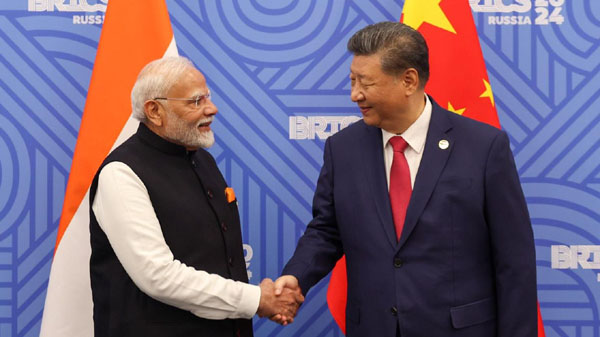By Dipak Kurmi
The relationship between India and China, two of the world’s oldest civilizations, has been a long and intricate saga of shared aspirations, trust, conflict, and evolving geopolitical realities. As they commemorate the Platinum Jubilee of their diplomatic ties, their history reveals a fascinating interplay of cooperation and competition, shaped by domestic ambitions and international dynamics.
When India and China first established diplomatic relations in 1950, it was a moment filled with promise. India was the first non-socialist country to formally recognize the People’s Republic of China (PRC) after its establishment following a bloody civil war. Under the visionary leadership of Jawaharlal Nehru, India pursued a policy of peaceful coexistence and non-alignment during the Cold War. Nehru envisioned an era where the two Asian giants could collaborate to promote regional stability. This vision was enshrined in the Panchsheel Agreement of 1954, which laid out five principles of peaceful coexistence: mutual respect for territorial integrity, mutual non-aggression, non-interference in internal affairs, equality and mutual benefit, and peaceful coexistence.
Despite these high hopes, challenges emerged early. China’s refusal to honor the McMahon Line, which demarcated the border between Tibet and India, and its invasion of Tibet in 1950 raised tensions. India’s decision to offer sanctuary to the Dalai Lama following the 1959 Tibetan uprising was perceived by China as an act of provocation, leading to accusations of meddling in its internal affairs. As trust eroded, skirmishes along the disputed border escalated, culminating in the 1962 Sino-Indian War, a conflict that left a deep scar in India’s collective memory. India suffered heavy casualties and lost territory in Aksai Chin, a strategic region China had already occupied.
The defeat of 1962 cast a long shadow over India-China relations, leading to decades of mutual distrust. The Cold War transformed global alliances, and as China began engaging with the West, particularly the United States, India viewed these developments with suspicion. Meanwhile, India, seeking to assert itself on the global stage, strengthened ties with the Soviet Union and later deepened its partnership with the US in the 21st century. The early optimism of Panchsheel gradually faded as both nations realized that their geopolitical and economic interests often diverged.
The late 1980s saw a thaw in relations when Indian Prime Minister Rajiv Gandhi visited China in 1988. This historic visit, occurring against the backdrop of China’s economic reforms under Deng Xiaoping, marked a turning point. Gandhi reaffirmed India’s stance on territorial integrity, especially regarding disputed areas like Aksai Chin, and paved the way for future diplomatic engagements. The relationship slowly improved, though issues like the status of Tibet, border disputes, and China’s increasing regional influence remained unresolved.
The rise of BRICS (Brazil, Russia, India, China, and South Africa) in the 2000s signified the growing economic and geopolitical importance of emerging markets. While India and China found common ground in multilateral settings like BRICS and the Shanghai Cooperation Organisation (SCO), their bilateral ties were frequently tested. For China, the SCO served as a platform to assert leadership in Central Asia and expand its influence over the Global South. For India, participation in the SCO was a strategic move to engage with its powerful neighbor while simultaneously counterbalancing Beijing’s increasing assertiveness.
China’s ambitious Belt and Road Initiative (BRI) further complicated the relationship. While China projected the BRI as a pathway to economic development through massive infrastructure investments, India remained wary, particularly regarding what it termed “debt-trap diplomacy.” India feared that China’s loans to smaller South Asian nations, including Sri Lanka and Pakistan, could lead to financial dependence and eventual political leverage for Beijing. The China-Pakistan Economic Corridor (CPEC), a major component of the BRI, further strained relations as it ran through Pakistan-occupied Kashmir, a region India claims as its own.
The Dalai Lama issue continues to be a thorn in Sino-Indian relations. India’s decision to provide refuge to the Tibetan spiritual leader is viewed as an enduring symbol of support for the Tibetan cause. Conversely, China perceives the Dalai Lama as a separatist and criticizes India’s position on the matter. Recent developments, including India’s stronger stance on human rights and deeper engagements with the West, have only intensified this friction.
India’s strengthening ties with the US have further complicated its relationship with China. The deepening strategic partnership between India and the US, particularly in the Indo-Pacific region, has heightened tensions with Beijing. China’s increasing militarization of the South China Sea, its expanding global footprint through the BRI, and its strategic maneuvers in South Asia place India in a challenging position. India, while keen to maintain its strategic autonomy, has nonetheless found common ground with Washington in countering China’s influence.
Despite the underlying tensions, the two nations recognize the importance of maintaining dialogue. Economic interdependence remains a key factor. China is one of India’s largest trading partners, and while trade imbalances persist, the economic relationship underscores a mutual need for stability. The border disputes, particularly the 2020 Galwan Valley clash, serve as stark reminders of unresolved territorial tensions, yet diplomatic and military-level talks continue in an effort to prevent further escalation.
As the world enters a new phase of geopolitical realignment, India and China find themselves at a crossroads. Both nations possess the potential to redefine global power structures if they choose to collaborate. Their combined economic and strategic strength could disrupt and reshape the current global order. However, historical grievances, competition for regional dominance, and conflicting strategic interests create formidable obstacles.
The future of India-China relations remains uncertain. While multilateral platforms such as BRICS and the SCO provide avenues for engagement, unresolved issues like border disputes, regional influence, and strategic competition will continue to shape their trajectory. As they celebrate seventy-five years of diplomatic ties, the fundamental question remains: will the Dragon and the Elephant find a way to cooperate and forge a new path, or will history continue to repeat itself in cycles of conflict and mistrust?
If they can transcend their differences and align their interests, their combined influence could challenge existing global structures, ushering in a new era of economic cooperation and technological innovation. The comparison to a “sleeping giant” is apt—just as China’s rise was once predicted to “shake the world,” the collaboration between India and China holds the potential to transform the geopolitical landscape. The choices they make in the coming years will determine whether their relationship will be defined by rivalry or a shared vision for a more balanced world order.
(the writer can be reached at dipakkurmiglpltd@gmail.com)




